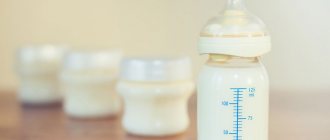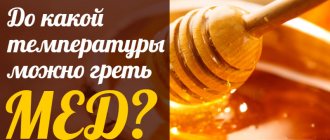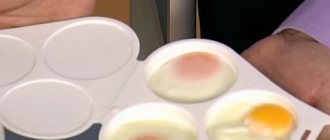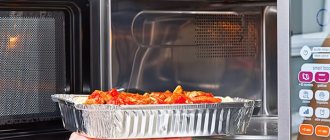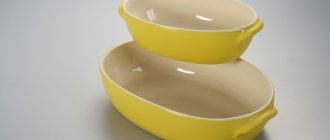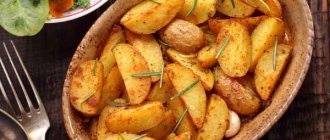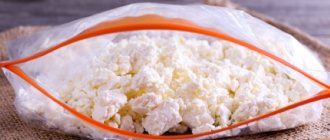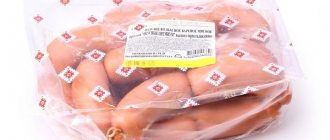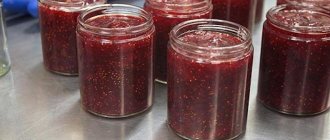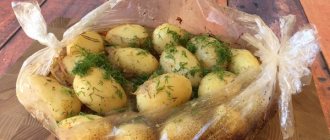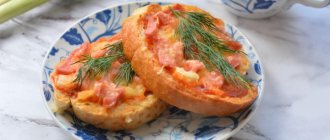It is believed that cooking or heating in a microwave oven destroys the nutrients contained in food. This is only partly true (proteins, fats and carbohydrates are preserved), but when there is a child in the house, you begin to wonder - is it possible to heat baby food in the microwave, and what are the risks?
Photo: Depositphotos.com. Author: Voyagerix.
Is it possible or not?
Any food that is cooled or heated undergoes changes: physical, chemical, structural and nutritional.
Many mothers are intimidated by the prospect of heating or cooking baby food in the microwave. But there are no studies proving the harm of this method. Provided that parents follow safety rules.
Dr. Komarovsky reports that heating in a microwave oven is not particularly different from other methods. The pediatrician makes an exception only for breast milk.
Is it possible to heat baby puree in the microwave?
All the myths that a microwave oven emits radioactive waves, changes the molecular structure of foods and makes them carcinogenic are complete nonsense. There is not a single confirmation of these myths, and even on the contrary, all the research conducted over the last quarter of a century suggests the opposite.
Therefore, I would like to assure all mothers who are worried about the health of their children - you can heat baby puree in the microwave.
The only thing I would like to remind you is that before you start feeding your baby puree heated in the microwave, you definitely need to mix it and try it, since the product may heat up unevenly and the baby may get burned.
Microwave risks
Risks associated with cooking or heating baby food in a microwave oven:
- Microwaves heat food unevenly. Even at the optimal temperature for the child, some pieces may be very hot. In the general mass, “hot pockets” often form that can burn the baby’s mouth.
- Using cheap plastic when heating or microwaving baby food can be harmful to children's health.
- The radiation emitted when a microwave oven is turned on can be dangerous to children.
Reduced nutritional value
Cooking dishes for children in a microwave oven inevitably reduces their nutritional value and changes the composition at the cellular level:
- The content of vitamin B12 decreases. It is important for the formation of red blood cells, preventing anemia and maintaining the health of the baby's nervous system.
- The concentration of flavonoids is reduced by 97%. These substances are powerful natural antioxidants and have anticancer, antimicrobial and anti-inflammatory properties.
- In breast milk, the level of antibodies (immunoglobulins) decreases, which should protect the baby from infections and contribute to the formation of its own immune defense.
- Breaks down enzymes that help your baby digest bacteria from breast milk. Babies need these enzymes to develop a healthy digestive system that can digest food, absorb nutrients from it, and protect itself from pathogens from the inside.
As you can see, constantly heating baby food (and especially breast milk for a newborn) in the microwave is a bad idea. Therefore, the device should be used only in extreme cases, when the mother does not have time to heat up any dish on the stove. And for infant formula and breast milk, it is better to use a special bottle warmer.
But this does not happen with all nutrients. For example, cooking baked apples in a microwave can only be beneficial: due to the high cooking speed, more vitamin C remains in the fruit. More details in this video:
Plastics leaching into food
Baby food placed in plastic containers should not be heated in a microwave. Many of them (as well as plastic wrap) contain carcinogens that easily leach into food.
Heating breast milk and infant formula in plastic baby bottles is also prohibited. When heated, such containers release toxins that affect nervous and reproductive health. Even in low doses, they can lead to cancer, early puberty, obesity and diabetes in the future.
Is it possible to heat cottage cheese in the microwave?
Almost all fermented milk products contain beneficial bacteria - probiotics. They increase the activity of immune cells, produce antibodies against pathogenic bacteria and suppress the growth of harmful microbes, thereby creating a balance of intestinal microflora.
Unfortunately, probiotics are destroyed when heated, so heating cottage cheese in the microwave is not advisable for a child.
Heating cottage cheese in a microwave oven significantly reduces the beneficial properties of the product. In addition, this is not particularly necessary, because few children like cottage cheese warm. It will be quite enough to simply remove the cottage cheese from the refrigerator and let it stand for 30-40 minutes at room temperature.
Precautionary measures
Photo: depositphotos.com. Author: belchonock.
Precautions that parents must take when working with a microwave:
- Use microwave-safe, heat-resistant glass containers.
- Avoid plastic containers. They can release dangerous chemicals into your food. Plastic bags (for freezing and storing food) are also unsuitable for this purpose. You cannot heat food in them.
- Cover food with a glass plate or lid while cooking or reheating. This will help retain moisture in the food.
- Make sure baby food is thoroughly heated. If not all bacteria are killed, this can result in food poisoning for the child.
- Do not be distracted for a long time from heating or cooking food in a microwave oven - it is easy to overheat or even burn food. At the same time, protein denaturation and loss of vitamins occur.
- After taking out the food, transfer it to another bowl. Then mix well to avoid any air pockets that could burn your baby's mouth while eating.
- Always follow the instructions supplied with the device to avoid problems.
- Reheating baby food should not be done more than once. Leftovers must be thrown away. Bacteria that get onto a spoon from a child’s saliva multiply in food debris very quickly and reach dangerous levels within an hour.
- If possible, use a food thermometer or temperature gauge to determine whether large pieces of meat or fish are heating evenly (the internal temperature immediately after removal from the oven should be at least 70 °C).
- Do not heat baby meat, fish or meat sticks, or eggs in the microwave. For these purposes it is better to use a stove. The foods listed have a high fat content, and since microwaves heat fats faster than other substances, there is a high risk of spattering and overheating.
- Always remove aluminum foil from microwaveable food - never place it inside the appliance.
- After heating baby food, formula or breast milk, always stir thoroughly and allow to cool to the ideal serving temperature.
- Always cover baby food with a lid before turning on the microwave.
Potato casserole with sausage and cheese in the microwave
Ingredients
- 2-3 medium potato tubers;
- 300 g boiled sausage or ham;
- 100 g hard cheese to taste;
- Mayonnaise to taste
- 1 tbsp. vegetable oil;
- Breadcrumbs to taste;
- Salt, pepper and other spices to taste.
Wash the potatoes, peel them, remove the eyes and dry them. Cut into thin slices using a sharp knife or a special grater.
Wash and dry the microwave baking dish. Place a third of the sliced potatoes in a thick layer. Sprinkle with vegetable oil, salt and pepper to taste, add spices and aromatic herbs.
Cut the ham or sausage into small cubes or thin strips. Grate hard cheese on a fine grater. Place the sausage pieces on top of the potatoes. Grease with mayonnaise. Then sprinkle everything with grated cheese.
Place a second layer of potatoes, sprinkle with vegetable or olive oil. Salt and pepper. Repeat layer of sausage, mayonnaise and cheese. Cover everything with a layer of potatoes and apply mayonnaise with a mesh.
Preheat the microwave oven at full power. Enable grill mode if your device supports it. Let the casserole dish cook for about 45 minutes. Check periodically to see if the potatoes are baked.
5 minutes before the end of cooking, sprinkle the dish with grated cheese or a mixture of cheese and breadcrumbs. Bring to full readiness at highest power. The casserole should have an appetizing golden crust.
Take out the finished dish and carefully cut into portions. Serve as a separate dish.
Warming baby formula in the microwave
While the baby is very young, the prospect of heating baby formula or breast milk in a microwave oven seems even more daunting. In fact, these liquids can be heated in the microwave (but not on a permanent basis):
- The main thing is to place a glass bottle (without plastic or rubber inserts) or a special safe container for the mixture there for no more than 10-15 seconds at medium power of the device.
- After heating, you need to shake the bottle well and check the resulting temperature of the mixture on your own wrist.
For infant formula, the optimal temperature is considered to be: 37-38 °C.
Even if mom does not have a bottle warmer, it is better to use alternative heating methods on a regular basis:
- Hot tap water. Place the bottle under hot running tap water until it reaches the desired temperature.
- On the stove. Heat water in a saucepan, remove it from the heat and place the bottle in it.
Packages for freezing breast milk: how to choose and how to use.
Can you heat a baby bottle in the microwave?
Well, we seem to have figured out which foods can be heated in the microwave and which cannot. But any mother, sooner or later, will have a question: is it possible to heat baby food directly in a baby bottle? Unfortunately, there is no definite answer to this question; here you need to proceed from the manufacturer’s recommendations indicated on the packaging.
But I would like to assure you that in our time, most manufacturers of baby bottles use only high-quality materials and plastic that can be heated in the microwave.
It’s worth paying attention to this even at the time of purchase; it will save you from unnecessary problems in the near future and will seriously make your life easier.
Ingredients
- 1 kg of potatoes (young ones with thin skin are better);
- 2 cloves of garlic;
- 5 tbsp. olive or sunflower oil;
- Paprika to taste;
- Pepper, basil, salt, other seasonings to taste.
Rinse potatoes under cold running water. Peel and remove the eyes.
Cut into large slices with a sharp knife and place on a paper towel. Wait until excess moisture comes out.
Prepare the dressing. To do this, pour olive or refined vegetable oil into a deep bowl. Peel the garlic and squeeze through a press.
Place the potato slices in the dressing for half an hour. Then take it out and rub the sauce in with your hands.
Turn on the microwave at full power. Place the potatoes on a plate and cook for 10 minutes. The slices will be soft and spicy.
Tips for defrosting baby food
Starting at 6 months, parents often introduce complementary foods into their baby's diet and begin to introduce their babies to solid foods. The practice of freezing foods for complementary feeding has become widespread due to the fact that it saves the time of a young mother and allows her to stock up on food for future use.
A microwave oven comes in handy here too - for defrosting cubes of baby puree and other complementary foods. But in addition to the safety rules indicated above, a number of other points should be taken into account when defrosting:
- Use only an appliance that has a “Defrost” or “Defrost” mode. The “Accelerated defrost” or “Turbo defrost” mode is also suitable (often this is a button with the image of two snowflakes and droplets).
- Always use microwave safe glass containers (marked with a special symbol - picture).
- If the appliance does not have a rotating stand mechanism, defrost the food in several stages - after a short period of time, turn off the oven, independently rotate the container to a certain angle, and turn on the appliance again.
- To defrost cubes of baby food from the freezer, 30-40 seconds of operating the microwave in the “Defrost” mode is usually sufficient.
- During natural thawing, it is recommended to thoroughly warm up already defrosted products (5-15 seconds) to avoid the rapid proliferation of pathogenic microorganisms in them.
- Allow food to cool to an acceptable temperature before giving it to your child.
Defrost mode icons in modern microwave ovens
Despite the fact that there are no reliable studies proving that food from a microwave oven is harmful, when working with baby food, it is better to use the device as little as possible.
What can't be heated?
You cannot heat or cook eggs in their shells in the microwave. Even broken eggs should not be placed in the microwave unless you have pierced the membrane enclosing the yolk. When heated, the yolk will begin to expand, the film will burst, and the microwave will have to be washed.
Do not heat baby food or breast milk in a microwave oven. They will lose their beneficial properties. Moreover, expressed milk becomes simply toxic and dangerous for the functioning of the kidneys.
It is not recommended to heat or microwave vegetables and fruits with their skins on. Especially potatoes. More precisely, the peel should not be intact. If you pierce it in several places or cut a vegetable, then excessive pressure will not be created in it from heating and there will be no danger that the potato will tear.
Some vegetables, such as broccoli, lose their beneficial properties.
Potatoes cooked in the microwave are less digestible.
Frozen berries and fruits, if defrosted in a microwave oven, lose almost all their beneficial properties and can even become carcinogenic.
